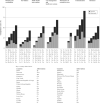Pandemic influenza preparedness in Africa is a profound challenge for an already distressed region: analysis of national preparedness plans
- PMID: 18381384
- PMCID: PMC7314001
- DOI: 10.1093/heapol/czn004
Pandemic influenza preparedness in Africa is a profound challenge for an already distressed region: analysis of national preparedness plans
Abstract
A new highly pathogenic strain of influenza virus, H5N1, has emerged causing severe outbreaks in poultry and high mortality rates when humans are infected. The threat of a new influenza pandemic has prompted countries to draft national strategic preparedness plans to prevent, contain and mitigate the next human influenza pandemic. To evaluate preparedness for an influenza pandemic in the African region we analysed African national preparedness plans available in the public domain. A data extraction tool, based on a World Health Organization checklist for influenza epidemic preparedness, was designed in consultation with pandemic influenza planning experts and experts on the region's public health challenges. Thirty-five plans were identified and available from 53 African countries. Most plans are relatively robust in addressing detection and containment of influenza in animals but strategic preparedness to respond to pandemic human influenza is weak. In most plans communication strategies have been developed with the aim to raise awareness of transmission factors and promote hygiene measures. By contrast, the human health care sector is ill-prepared. Case management, triage procedures, identification of health care facilities for patient treatment (including home care and provisions for the distribution and administration of pharmaceuticals) are poorly addressed by most plans. The maintenance of essential services in the event of a pandemic is absent from most plans. Whilst many African countries have strategic pandemic influenza preparedness plans, most are developmental in nature and lack operational clarity, or focus principally on the containment of avian influenza rather than pandemic human influenza. Clear strategies, that are operational, need to be developed that reflect the realities of national context and resource constraints and that meet national objectives. These objectives need also to be coherent with international imperatives such that the global threat of pandemic influenza can be met effectively and efficiently.
Figures
References
-
- ALive. Avian influenza prevention and control and human influenza pandemic preparedness in Africa – Assessments of financial needs and gaps. Fourth International Conference on Avian Influenza; December 6–8, 2006; Bamako, Mali. 2006.
-
- Coker R, Mounier-Jack S. Further thoughts on the limitations of a recently published review of national influenza pandemic in Europe. Eurosurveillance, May 4. 2006;11:E060504.3. - PubMed
-
- Mounier-Jack S, Coker R. How prepared is Europe for pandemic influenza? An analysis of national plans. London: ECOHOST, London School of Hygiene and Tropical Medicine; 2006. April. - PubMed
-
- Mounier-Jack S, Coker RJ. How prepared is Europe for pandemic influenza? Analysis of national plans. The Lancet. 2006;367:1405–11. - PubMed
Publication types
MeSH terms
LinkOut - more resources
Full Text Sources
Medical
Miscellaneous



